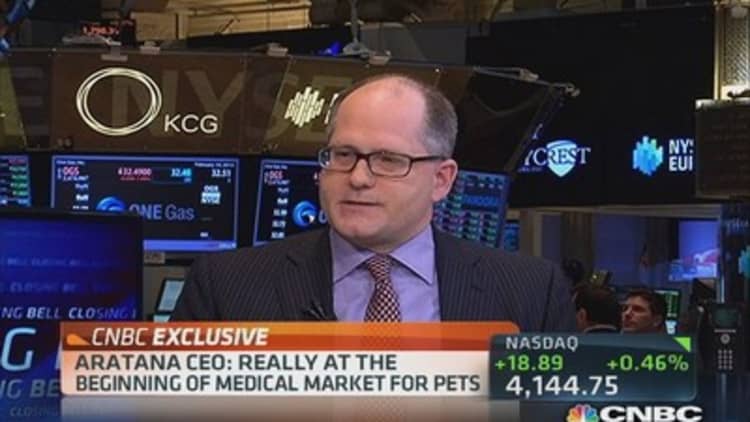When Nichole Mayer, 29, married her boyfriend last August, they already had a family in place: two bulldogs, Bella and Winston. "We joke that they're our kids," said the San Diego resident. "They need a lot of looking after, but they give you so much love."
Mayer isn't alone. A record number of Americans have pets—about 68 percent of U.S. households in 2012, or 82.5 million, according to the American Pet Product Association (APPA). And, trendwatchers say, our emotional bonds with our pets are growing closer. Increasingly, we feel that Fido and Fluffy are part of the family.
But as with other family members—like children—providing for them can be expensive.

Of course, doggy school costs a lot less than college, and you won't have to worry about clothing your cat. Still, the Association for the Prevention of Cruelty to Animals (ASPCA) calculates that you'll spend at least $1,580 for a medium-sized canine pal in the first year and $1,308 for the feline variety, with minimum outlay of $695 and $670, respectively, for every year thereafter. Those totals include spaying and neutering, vaccinations, food, treats, toys, training, licensing, leashes, other supplies and routine veterinary care and medicines. They do not include the cost of boarding or sitting, which can be significant, depending on how much you're away from home.
You'll spend at least $1,580 for a medium-sized canine pal in the first year and $1,308 for the feline variety.Association for the Prevention of Cruelty to Animals
The cost of pampering
As a nation, our spending on our beloved animals has risen almost 10 percent in the last two years to $55.5 billion, according to APPA estimates, fueled in part by our desire to pamper our four-legged friends with luxury services and products, including grooming, pet hotels and holiday and birthday gifts. (And most of our pets are four-legged. The most popular: dogs, owned by 46.7 percent of the population, and cats by 37.3 percent.)
Health-care spending is up, too. The ASPCA says annual recurring medical expenses start at $160 for a cat and $230 for a medium-sized dog, plus health insurance for around another $200 a year (though it can cost more). But what's not reflected in their calculations are the often daunting expenditures that can pop up when your pet becomes injured or ill.
Keeping Fluffy in shape
While veterinarians say the best way to avoid or minimize expenses over a pet's life span is to invest in preventative care, pet owners have been making fewer visits to the vet, according to the Association of Veterinary Medicine (AVMA). It calculated that while dog visits to the vet went up 9.2 percent from 2006 to 2011, the percentage of households not taking their dogs to the vet at all increased by 8 percent. Households never taking their cat to the vet were up by a startling 24 percent, with cat visits overall down by 4.4 percent.

"So many diseases are preventable with relatively little cost upfront," said Dr. Kimberly May, AVMA's assistant director of communications. "Getting teeth examined and cleaned regularly will prevent serious dental problems—and overall health issues—down the road. Vaccines are available for deadly diseases like canine parovirus and distemper. And checking for heartworm is significantly cheaper for you—and much better for your dog—than treatment."
The rapid evolution of veterinary medicine in the past five to 10 years has put upward pressure on the price of pet care. Vets can now treat almost all the same problems in animals that we experience as humans. But the price of tests and procedures can be eye-popping. Simply removing a foreign object from a cat's stomach or intestines, a frequent issue, can run close to $2,000. Treating cancer or replacing a joint—two conditions more common in pets now that they're living longer—can multiply that figure. Radiation therapy for a dog, for example, can range from $2,000 to $6,000, while a hip replacement could run close to $5,000.
(Read more: Making your new year financial resolutions stick)
Budgeting for everyday emergencies
While credit plans may be available through your veterinarian, you can help budget for your pet's care by creating a dedicated savings account and setting aside money every month earmarked for health expenses. If your animal experiences a serious medical event, though, your funds may fall short. For owners who want to provide whatever care their pets need—but worry they won't be able to afford it—pet health insurance can be a good idea.
Bella, the 10-year-old owned by Nichole Mayer and her husband, had to have leg surgery five years ago. She wasn't insured, so they had to pay the sizable bill in full. When Winston came along as a puppy three years ago, her vet recommended insurance. Mayer is glad she has it. "I've used it for big stuff and ordinary stuff—everything," she said. "When he ended up eating an entire chew toy, it was scary and expensive. But I was reimbursed the full $1,500 cost of treatment."
Mayer's insurance company is Veterinary Pet Insurance (VPI), the nation's oldest and largest pet insurer, and others include PetHealth and the Hartville Group. Policies for pets work much like those for people, though preexisting conditions usually aren't covered, and you typically pay bills upfront and are reimbursed by the insurance company. How much you'll pay generally depends on the level of coverage, the deductible you choose and the age of your pet. The older the animal, the more you'll pay; many insurers won't even cover pets after they're 10 years old.
Not everyone is sold on the concept of pet insurance. In a 2011 article, Consumer Reports recommended against it for most healthy animals, saying its research showed it usually didn't reduce total health-care spending. Those in the pet industry, though, say the point of any kind of insurance is risk management; it's not about whether you'll pay more over time but whether you're protected in case something terrible happens.
(Read more: Your best money moves to make in 2014)
Is pet insurance worth it?
More employers are signing onto the idea, offering pet health insurance to their workers as a benefit option. VPI said that 1 in 3 Fortune 500 companies now offer its coverage.
Every company in the U.S. selling pet health insurance must be licensed in all 50 states, so it's a well-regulated industry. But policies vary considerably in terms of costs and benefits; you need to scrutinize them carefully before choosing one. Some policies will cover things like routine exams and vaccinations (often termed "wellness policies"), but others may not. Some are for emergencies only, while others cover a full range of services, including wellness care and coverage for conditions other policies may exclude. Examples of the plans and prices offered by VPI range from injury-only for dogs ($10 monthly), wellness packages for cats and dogs ($12 to $22), basic medical coverage for cats ($12 to $17) to comprehensive coverage, including hereditary conditions, for dogs ($25 to $35).
But that's just a starting point. As with most insurance, you'll pay lower premiums by choosing a higher deductible, and vice versa. You should check whether the deductible is yearly or per incident. What's covered and what's excluded? Cats often have thyroid problems, for example. If your cat develops thyroid issues, will treatment be covered? How much will the policy pay—a percentage of actual costs or a percentage of amounts deemed reasonable and customary? Are there annual or per-condition or life caps on coverage?
"The first thing you should do is talk to your vet about your specific pet and what his risks are likely to be," said Kristen Lynch, executive director of the North American Pet Health Insurance Association, which advances education and communication about the industry. You'll want to find a policy that covers the most common scenarios you might encounter. Then shop around, immerseing yourself in the specifics of the policies. Gauge each company's personality by talking to someone there.
"It's important, because when you're dealing with pet insurance, it's an emotional process," Lynch said.
—By Robin Micheli, Special to CNBC.com




